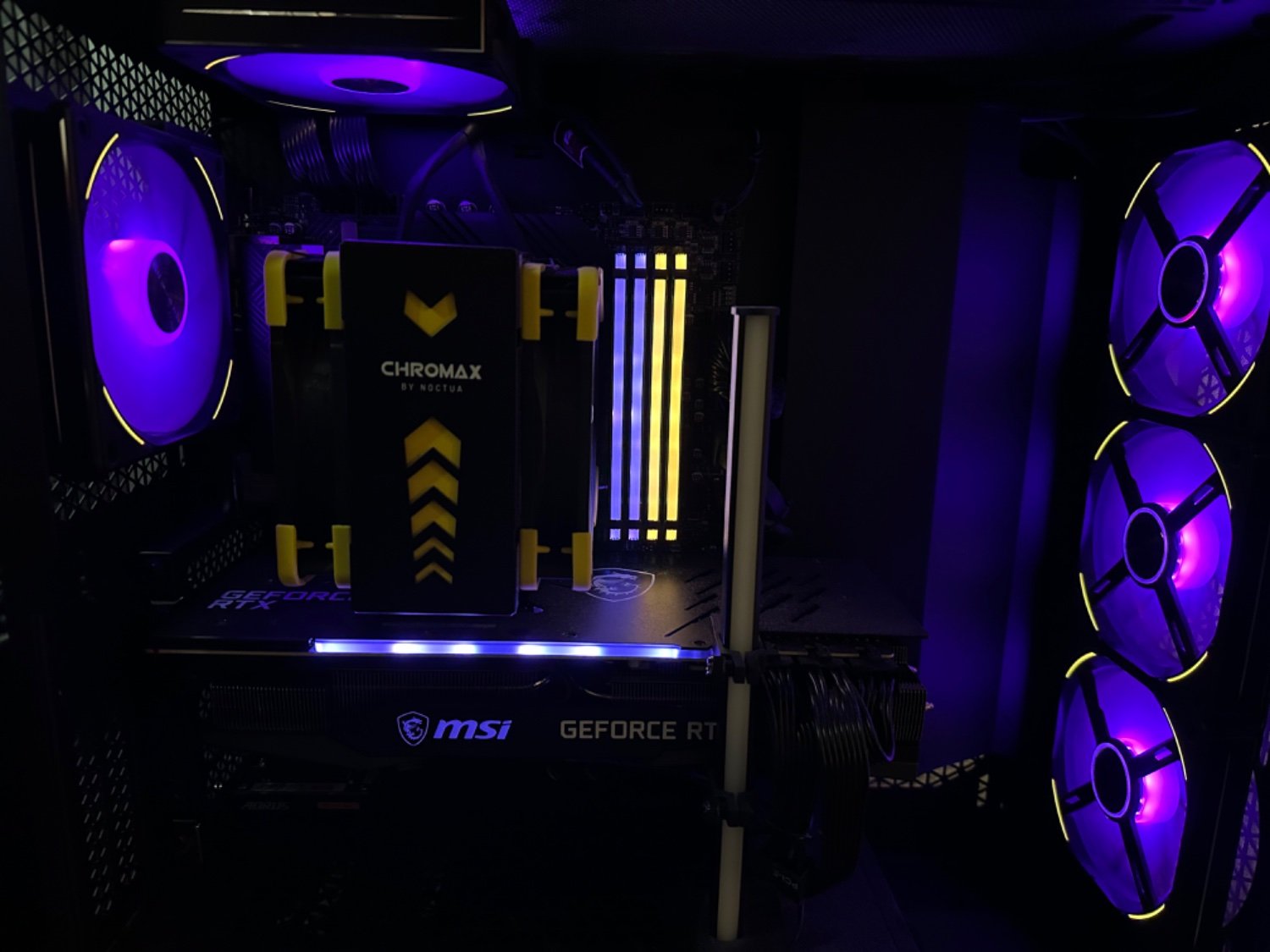Hi! I currently have this build using the GT502 case.
I just recently got 3 more case fans. Previously it was set up like this:

I think that for some reason the temps got worse and the PC much louder. It might just be buyer’s remorse but I got more fans so that they could use less RPM and be quieter, but I feel like the complete opposite has happened.
Can I change anything about this layout to optimise airflow? I was thinking of maybe switching the side panel fans to exhaust? That might starve the CPU cooler, though…
Maybe I’m just imagining things and I just need to perform exact tests to figure it out. What do you use for testing airflow effectiveness?
UPDATE:
The issue was weirder than I would’ve thought. The bottom 3 fans are controlled by one motherboard channel using a PWM splitter cable. The rear and side panel fans are the same - one channel for all 3. Previously I had just the rear exhaust plugged in to a single channel but now it’s plugged into the splitter.
Apparently the order of the fans in the splitter is VERY important. I changed it so that the rear fan is the first in the splitter and that instantly fixed the issue. ¯\_(ツ)_/¯
Is the top mesh or solid? I can’t tell.
Very loud noise/vibration typically means too much positive pressure, the fans are fighting each other.
If mesh you shouldn’t be having any problems with rear exhaust and the rest intake… I’d just tune the rear exhaust to match the cpu fan and run the rest on a much, much less aggressive ramp up.
If solid, leave bottom 3 intake, rear exhaust, side two exhaust. This leaves the air pressure net balanced but keeps air flowing consistently up through the case. The gpu will get plenty of fresh air, the side two exhausts takes care of the gpu air, and the rear exhaust will ensure there’s a natural flow towards the cpu cooler and won’t starve it.
Try this setup:
- Bottom - Two intake fans
- Side - Two intake fans
- Rear - One exhaust fan
- Top - One exhaust fan
Tl;dr:
With this proposed setup, aim for slight positive pressure by setting your exhaust fans at a higher speed than the four intake fans (e.g., exhaust - 900 rpm, intake - 800 rpm). This may give you the best balance in noise, cooling, and airflow.
Advantages of this new setup:
- Reduces noise since you can set all fans to a comfortable speed
- Optimises airflow to achieve either neutral pressure (ideal) or slightly higher positive pressure to reduce dust
- Exhausts hot air at a rate that does not allow the air in the case to heat up
Explanation for changing your setup to my proposal:
Mount the top exhaust fan as far left as possible (over the top left corner of the motherboard). The ideal airflow pattern in any system, not just computers, is to get air in at the same rate as you get air out. The ideal is neutral airflow where there is no pressure buildup in a case - air leaves as quickly as it comes in. The next preferable pattern is positive pressure - simply because it helps to reduce dust - where a slightly higher volume of air is brought in than exhausted.
With your current setup, you have too much positive pressure, which is very bad for cooling. You’re introducing an unnecessary volume of air that’s bouncing around in that case. While it sounds like shoving more air into the case would be great for cooling, the problem is that air isn’t leaving the case fast enough! So what happens? You’re shoving so much air into that case at such a fast rate, and it has nowhere to go! Sure you’ve got one exhaust fan that’s trying to pull some air out of the case, and I guess you have some breathing holes at the top, but there’s nothing up there to direct that air, so air will partially get pushed out of there slowly. Meanwhile, you’re still shoving so much air into the case. Air is also forcibly shoved everywhere in the computer, gets pushed in all the cracks and crevices in that case (e.g., between the glass and the case), and small amounts of air get squeezed out from those cracks. The air in the case is somewhat trapped and it actually gets hotter since it can’t exit quickly enough! Your CPU and GPU heat up the intake air, and this is why your temps are worse by adding those three intake fans. You need to get the hot air out at the same rate it is coming in, and exhaust fans will do that for you.
Key: The air coming in should leave the case at the same rate. A compromise, where the only benefit is to help reduce dust, is to have the air leave the case at a slightly lower rate than it came in.
You only need to adjust your setup so you have two exhaust fans: one rear and one top. You’ll see other builds with three fans mounted on the top for exhaust, but that is extremely wasteful and misguided. Those extra fans end up exhausting cool intake air before it even has a chance to flow over the motherboard and other hot components.
Set your exhaust fans slightly higher than the speed of your four intake fans to help balance them out. It is two exhaust vs four intake, so you can try something like this: intakes at 800 rpm, exhaust at 900 rpm. Of course, set up appropriate fan curves when you’re introducing load to the CPU and GPU so they ramp up appropriately.
As for optimization, your definition of noise may be different from others. Introduce sustained load to your PC, and then while you have that load, play around with your fan settings to figure out what you’re comfortable with and set the fan curves appropriately so that they gradually ramp and stay at consistent speeds.
@Ansis@iusearchlinux.fyi - I’ll add my setup just as a reference point.
- Case: Corsair 5000d
- i7-12700k
- RTX 3080
- Noctua UH-14S CPU cooler with the two included Noctua fans
- Front: Three intake fans
- Rear: One exhaust fan
- Top: One exhaust fan
I have been very happy with the level of cooling and have set up the fans to achieve slight positive pressure. This case supports side fans, but I did not add any since they were unnecessary and would just introduce more noise with less benefit.
Pardon the dust and bad lighting - it is overdue for a cleaning but I hurt my back a few months ago and I can’t lift my computer safely to bring it outside and blow my computer air duster through it. Plus the darkness helps hide the dust. 😉:

The easiest hack for testing airflow is to burn an incense stick and see where the smoke goes.
This reminded me that I too probably have a bad airflow.
I did optimize curves for silence when not gaming but with helldivers I noticed I am hitting just a bit too high temps on CPU then I am used to.
I have two 140mm front coolers, and 240 liquid top-mounted CPU cooler (2x 120 coolers, pushes air out through the radiator), no exhaust fan but the fractal north case has pretty open back side so the theory was that whatever extra pressure there is it’s going to out the back but I think the front intake fans might not be configured properly (3080 and lightly undervolted 13900kf).
I’d make the back and bottoms intake and exhaust on the side with that config.
Or intake on the side and exhaust in the back and bottoms.
Or mouth the side ones on top as exhaust if possible.
Back intake means your are fighting the airflow from the CPU cooler unless you switch that one around, too, and pretty much reverse the whole airflow in the case.
Don’t think that makes too much sense. Cases these days seem to follow a “front in, back/top out” airflow philosophy anyway.



